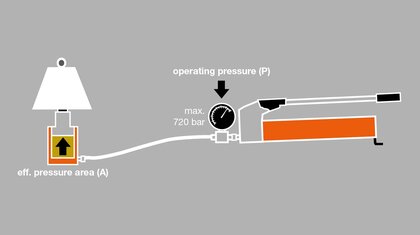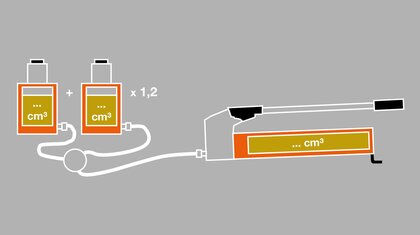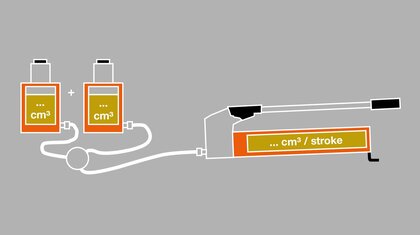The power of hydraulic driven tools lies in the fact that you can move a large load by fluid under high pressure (700 Bar / 10.000 Psi). A hydraulic cylinder (also known as a jack, bottle jack, press, small press, small bottle, pump or small pump jacks) is used to move heavy objects. This can be done by lifting, lowering, pushing, pulling, pressing, spreading. Our hydraulic cylinders operate on the basis of high pressure hydraulics. This means that the cylinders can handle an operating pressure of 700 Bar / 10.000 Psi. The hydraulic pump forces hydraulic oil into the cylinder. The pressure in the cylinder increases, causing the cylinder's plunger to be pushed out, enabling you to lift, lower, push, pull or spread.
700 Bar cylinders are available in 3 different return types:
GRAVITY RETURN (e.g. HJ50G30)
Return of the plunger by means of the load or another external force.
SPRING RETURN (e.g. HGC25S25)
Return of the plunger by means of a spring integrated in the cylinder.
HYDRAULIC RETURN (e.g. HAC50H10)
Return of the plunger by means of hydraulic pressure. A.k.a. ‘double-acting’ cylinders.



Basic knowledge of hydraulic Tools
Working with 700bar is not to be taken lightly. Therefore, always keep these ground rules in mind when working with high-pressure hydraulics:

RECOMMENDED TOTAL CYLINDER CAPACITY
In connection with various uncertainties, we always recommends a system with sufficient extra capacity:
- The exact weight of the total load
- The spreading of the load among the cylinders
- Possible moving of the load in case of calamities
DO YOU FEEL THE PRESSURE TO WORK SAFE? USE YOUR BRAIN!
Believe in creating a safe and neat work environment
Read the instructions and use the equipment as specified
Always work with Personal Protective Equipment
Inspect your equipment; scheduled maintenance and certification is required
Never work with damaged equipment!
Correct & periodic maintenance can prevent unnecessary damages, costs, and unsafe situations.
To make sure you are working safe with high-pressure hydraulics, have your tools regularly tested & serviced:
- At least once a year
- With use of dynamic testing
There is only one correct way to determine if a hydraulic system is safe to use: dynamic testing. With dynamic testing, a max use situation of the cylinder is simulated in a controlled environment. By doing so, hidden defects will be identified sooner, ensuring the reliability, safety & lifespan of your tools.
- Specially for high pressure hydraulics > 500 bar
- 105% over pressure
Which items in your hydraulic system require periodic maintenance, in order to work safe?
Hydraulic pump-unit: the motor of your system; regulates the oil flow & working pressure in the system. To maintain safety in the hydraulic system, a pressure relief valve is indispensable.
- Hose: transport of oils from the hydraulic pump unit to the cylinder(s)
- Cylinder: your hydraulic tool to lift high tonnage, with a small surface
The whole hydraulic system functions under high pressure (> 500 bar). The system components may bare both visible and invisible malfunctions.
You want to learn more on working safe with hydraulics?
Safety data sheets
Unprofessional use of high-pressure hydraulic tools occurs on a regular basis. Our safety sheets list all the dos and don’ts for working with hydraulic lifting tools in a straightforward and conveniently organized manner. These are indispensable in every workplace where hydraulic tools are used.






